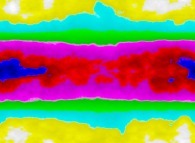
A 'crumpled' torus defined by means of three bidimensional fields [Un tore 'froissé' défini à l'aide de trois champs bidimensionnels].

A 'crumpled' torus defined by means of three bidimensional fields [Un tore 'froissé' défini à l'aide de trois champs bidimensionnels].
X = Fx(u,v)
Y = Fy(u,v)
Z = Fz(u,v)with:
u ∈ [Umin,Umax]
v ∈ [Vmin,Vmax][Umin,Umax]*[Vmin,Vmax] then defined a bidimensional rectangular domain D.
v ^
|
V |...... ---------------------------
max | |+++++++++++++++++++++++++++|
| |+++++++++++++++++++++++++++|
| |+++++++++++++++++++++++++++|
| |+++++++++++++++++++++++++++|
| |+++++++++++++++++++++++++++|
| |+++++++++++++++++++++++++++|
| |+++++++++++++++++++++++++++|
| |+++++++++++++++++++++++++++|
| |+++++++++++++++++++++++++++|
V |...... ---------------------------
min | : :
| : :
O------------------------------------------------->
U U u
min max
X = Mx(i,j)
Y = My(i,j)
Z = Mz(i,j)with:
i = f(u,Umin,Umax,Nu)
j = g(v,Vmin,Vmax,Nv)where 'f' and 'g' denote two obvious linear functions...
 Fx = fractal(u,v).(R+r.cos(u)).cos(v)
Fx = fractal(u,v).(R+r.cos(u)).cos(v)
 Fy = fractal(u,v).(R+r.cos(u)).sin(v)
Fy = fractal(u,v).(R+r.cos(u)).sin(v)
 Fz = fractal(u,v).r.sin(u)
Fz = fractal(u,v).r.sin(u)
 ) for the 'X', 'Y' and 'Z' coordinates.
) for the 'X', 'Y' and 'Z' coordinates.

 See the perfect torus.
See the perfect torus.